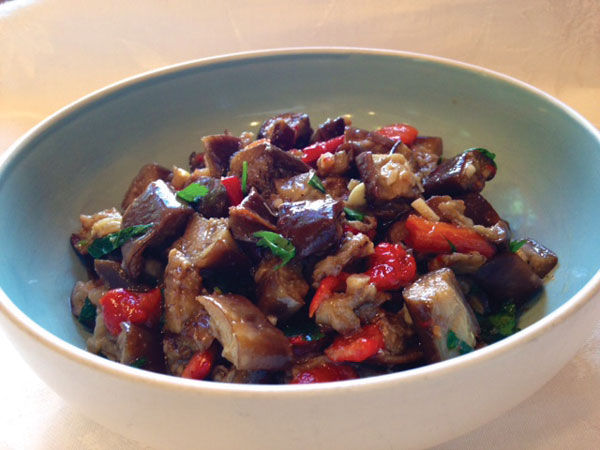Moroccan cuisine makes a plentiful, spicy seder
Published April 13, 2016
Centuries of religious intolerance and oppression forced generation upon generation of our ancestors to flee their lands in search of some sanctuary in the Diaspora where they could live in peace as Jews. And along the way, they developed unique cuisines that were in keeping with the laws of kashrut but reflected the native ingredients, flavors and cooking techniques of their new homelands.
The Passover holiday showcases these cuisines. For example, rice, beans and corn are three foods prohibited on Passover for the Ashkenazi of European descent, while all three of these foods may be featured in a seder meal of the Sephardim of Spanish, Portuguese, North African and Middle Eastern descent. Moreover, within each of the Sephardic subcultures (as with the Ashkenazi subcultures), the specific country of origin defines its Passover cuisines.
Take, for example, Jews from Morocco. Once there were more than 250,000 Jews in Morocco. Fewer than 2,500 remain. Most resettled in Israel in the 1940s and now are the second-largest Jewish community in Israel.
Jews of Moroccan descent, in Israel and here, have preserved their culinary traditions, including on Passover. Moroccan cuisine is known for its panoply of spices, from cumin to cinnamon, coriander to cloves, cardamom to allspice, and ginger to paprika.
Janet Rodgers, mother of three and the co-head of Visioning and Leadership for Central Reform Congregation, recently returned from a 10-day trip to Marrakech.
“I was determined to bring back spices,” she said. “I flagged a cab in Marrakech and asked the driver to take me to the spice market. He told me that the best shops are in the old Jewish quarter. There are tons of them.”
The celebrated Moroccan chef Mourad Lahlou, in his cookbook “Mourad: New Moroccan,” confirms this.
“In Marrakech,” he writes, “there’s really one place to buy spices: the old Jewish section of the medina called the mellah.”
Janet said that in that old Jewish quarter, “I bought lemon curry, cumin, sweet paprika, a hot spice mix, a delicious herbal tea with a lots of weird plants in it, and ras el hanout, which was a mix of 35 spices. It was an amazing experience.”
Ras el hanout means “head of the shop” and is an amalgam of premium spices ground together.
Along with the spices, preserved lemons are a dominant feature of many Moroccan dishes. They provide an umami flavor that is both mildly tart and very lemony. Preserved lemons are made by combining fresh lemons in a jar with coarse kosher salt, freshly squeezed lemon juice, black peppercorns and bay leaves. The mixture is set aside and allowed to brine at room temperature for three to four weeks.
A tagine, a two-part cylindrical vessel whose domed lid tapers at the top, is used to make traditional stews (tagines) from assorted meats, vegetables, fresh herbs and dried fruits. As the well-spiced stew cooks, a luscious thick sauce forms in the base of the tagine. The sauce results from the steam of the cooking stew rising up into the cooler tapered lid. As that moisture falls back down into the food, the flavors concentrate and the resulting tagines are succulent.
Cold and warm salads are a staple of Moroccan cuisine and showcase the variety of fruits and vegetables native to that area: lemons, oranges, dates, olives, grapes, fava beans, eggplants, peppers and root vegetables such as carrots, turnips and rutabagas. No meal is complete without multiple salads. I was curious to know just how some of these classic dishes are served at a traditional Moroccan seder.
Liora Kushner helped me understand. Reared in Israel by Moroccan parents who moved there from Fez in the 1950s, Liora grew up eating Moroccan food. After serving in the Israeli army, she studied law and then moved with her husband, Ohad, to Boston. The couple have three children. In an effort to spend more time with her family, Liora traded in her law career to become a caterer. Liora’s Catering (liorascatering.com) in Chestnut Hill, Mass., specializes in kosher Mediterranean food.
Passionate about Moroccan food, Liora delights in sharing her love of this cuisine with her customers.
“Our seder meals were plentiful,” she told me. “My mother prepared about 20 small salads, all very colorful.”
What types of salads?
“Slow-cooked tomato sauce with garlic, paprika, cumin, cilantro and assorted peppers,” Liora said. “And a Moroccan salsa of cooked poblano and sweet red peppers called matbucha; fresh tomatoes with roasted hot peppers and preserved lemons; roasted eggplants; fresh grated sweet carrot salad; cooked beet salad served at room temperature or cold; assorted quick pickles such as fennel with dill and cauliflower florets with carrots.”
She explained that these salads would be followed by fish fillets cooked in a pan on top of the stove in a red tomato-paste sauce seasoned with harissa (North African pepper paste), cumin, paprika, salt and pepper and topped with preserved lemons.
Liora’s description of her seder meal had me swooning. It also sounded as if it was enough food to feed an entire neighborhood. But, she insisted, that was only the beginning of the meal.
Next on the menu, she told me, was chicken soup with matzah balls, a tradition that her mother borrowed from her Ashkenazi friends in Israel. Following were three fish dishes: baked, fried and stewed.
And then, three chicken dishes: drumsticks with beans, potatoes, and tomatoes; whole roasted chicken with Moroccan spices; and chicken tagine prepared with onions, celery, carrots, honey, tomatoes, paprika and turmeric, and layered with prunes, dried apricots and raisins.
Incredibly, beef is also on her menu. Two dishes: ground and stuffed inside fresh artichokes; and a beef shoulder with green olives stewed with chilies and red peppers, turmeric and fresh tomatoes.
“When my parents lived in Morocco,” Liora told me, “everyone would take their beef stews to the neighborhood bakery, where the stews cooked slowly overnight at a very low temperature.”
Liora’s seder meal concludes with cooked and fresh fruits, and cookies made with chopped and sliced almonds, and confections made from marzipan paste in fruit and vegetable shapes.
“By the end of the seder meal, everyone is exhausted,” Liora said. “Exhausted and happy.”
The foods on Liora’s seder menu are resplendent with the spices, flavors and colors of classic Moroccan cuisine. I look forward to including some of these dishes at our upcoming seder. Should you wish to do the same, here are a few easy-to-follow recipes. Plan to cap off your seder meal with a cup of fresh mint-steeped tea, a Moroccan tradition now popular in Israel.
Have a lovely Passover.
Margi Lenga Kahn is the mother of five and grandmother of five. A cooking instructor at the Kitchen Conservatory, she is working on a project to preserve the stories and recipes of heritage cooks. She welcomes your comments and suggestions at [email protected].














